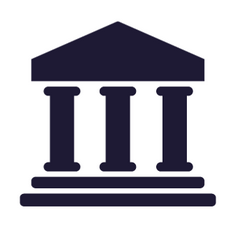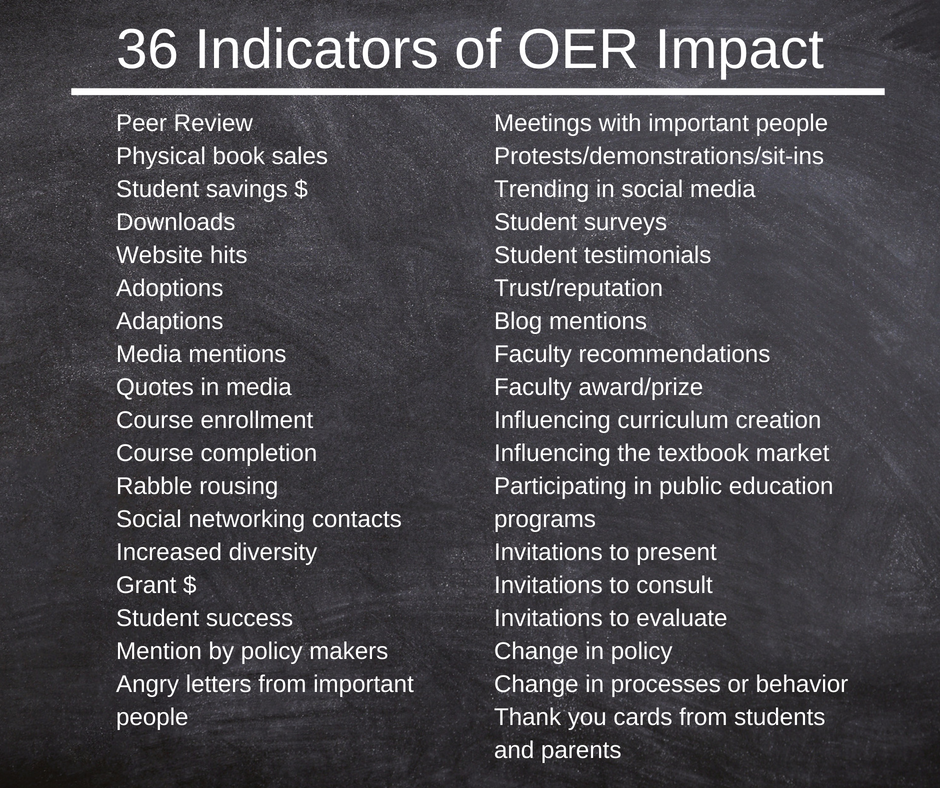Strategies & Steps for Growing OER Initiatives (continued)
 Department/Institutional Level
Department/Institutional Level
At the department level, a few Ontario institutions have created a center dedicated to supporting the development of open educational resources. Formal centers can provide wrap around support for faculty who may struggle with the technical aspects of publishing, and also rapidly build awareness in the institution. Planning an initiative on this scale requires a business plan outlining the overall goals, structure, funding, and reporting metrics.
- Policies and Plans
- Organization Structure and Roles
- Resource Needs & Funding
- Processes
- Metrics
- Communication Plan
Policies and Plans
By adopting high-level open education policies and guidelines, institutions signal their commitment by making open education integral to their mission. Of course, policies don’t exist in a vacuum; they are borne out of a need to establish and codify an institution’s procedures (Skidmore & Provida, 2019). An open policy model may include: inclusion in strategic plan, tenure/promotion considerations, intellectual property rights, required educational resources, institutional groups and committees, roles, funding and technology/infrastructure required.
Resources
- Research Report – A Place for Policy: The Role of Policy in Supporting Open Educational Resources and Practices at Ontario’s Colleges and Universities
- Kwantlen Polytechnic University’s Open Education Strategic Plan (2018-2023)
- Open Washington – Open Educational Resources Network OER Policy Videos
- OER Policy Development Tool
Organization Structure and Roles
The structure of the department will be unique to each institution. Some of the key roles and duties required to provide wrap-around support to faculty and staff creating OER include those listed below. The duties listed may be part of a shared role across departments or may form part of an individual’s overall role within the institution.
| Role | Description |
|
Project Manager |
Manages all the OER projects coming into the department. They are responsible for tracking progress and liaising with the subject matter expert (SME) and department staff to ensure the project is on track and meets completion goals. Helps to build awareness across the institution, and networks with others in the open community. Fanshawe College Project Lead Role Reflection |
|
Instructional Designer / Quality Assurance |
Works with the SME and utilizes instructional technologies to develop Open Educational Resources (OER). The instructional designer will provide guidance around effective use of the technology and pedagogy. Fanshawe College Instructional Design Role Reflection |
|
Graphic Designer |
Receives direction from the project lead and instructional design team to meet faculty needs in building high quality digital learning resources. Ensures designs meet accessibility standards and are copyright compliant. Sources stock photography where required. Fanshawe College Graphic Design Role Reflection |
|
Copyright Consultant or Librarian |
Reviews open resources for copyright infringement. Requests permission where needed to re-use resources. Provides suggestions of alternative resources that can be used in the creation of newly adapted works. Provides guidance on attribution statements and formatting. Could be combined with OER librarian role. |
|
Research or OER Librarians |
Assists in locating open educational resources for faculty and students. Produces environmental scans for open resources based on course learning outcomes or topics. Sample Environmental Scan Template. |
|
Accessibility Specialist |
Reviews open resources to ensure they meet accessibility requirements. Recommendations and training provided to ensure resources are accessible. Accessibility Toolkit & Checklist |
|
Copyeditor |
Reviews and edits digital learning resources to correct spelling, grammar, syntax, and punctuation errors. They check text for readability and consistency with a style guide, and rewrite text to improve clarity and readability. |
|
Photographer |
Works with subject matter experts and instructional designers to take professional quality photos for use in open resources. |
Students can be hired as part of their practical learning experience. Students can be hired through both work study, international work study, and co-op positions. Fanshawe College Sample Student Role Descriptions.
Funding
Funding required to form a new open education department includes resources to staff the department, any technological needs, including software licenses, as well as money available for grants. Additional funds may be required for memberships with open organizations and professional development. The following are some resources to help develop an OER grant program at your institution.
Resources
- Ontario Open Library Network OER Grant Program Templates
- BCcampus Open Education Resources Grant Program
- Examples: Fanshawe OER Grant Program, McMaster OER Grant Program, University of Ottawa Library OER Grant
Processes
Processes are essential for ensuring the department runs effectively. Processes required to run a department could include: OER environment scan process, OER development process, OER adoption process, and OER grant process.
Resources
- Fanshawe OER Design Studio Processes
- Seneca OER Workflows
- CLO Free the Textbook Workflow
- Other Workflow Examples
Metrics
There are several ways to measure the impact of open education initiatives. The metrics tracked will depend on the overall purpose and value proposition of the initiative. It is important to identify the metrics to be tracked at the beginning, as it can be difficult to go back and try to locate the information after the fact. Metrics can be tracked in software if available, or by using spreadsheet software.
According to David Wiley, the key metrics for measuring the student impact of open educational materials are success, scale, and savings (3S’s).
Defining Success
Success means a student has completed a course with a final grade that allows the course to count towards graduation. According to Wiley, the impact of student success occurs most clearly between the boundary of C and D final grades as a small change here in the final grade has a large impact on graduation. To learn more about how this can be calculated to show the impact of OER on student success, read S3: A Holistic Framework for Evaluating the Impact of Educational Innovations (Including OER).
Defining & Measuring the Scale of Success
Measuring Success: The proportion of students being reached.
Scale = Number of Students in OER Sections / Number of Students in All Sections
How many of our students are benefiting from this innovation?
Defining and Measuring Savings
Savings: The amount of money spent on course materials by the average student using OER compared to the amount of money spent on course materials by the average control student.
Savings = Average amount spent control – Average amount spent on OER / Average amount spent control
How much money does this innovation save students?
Wiley provides a final impact formula based on relative weights for each of the 3S’s which can be found here: S3: A Holistic Framework for Evaluating the Impact of Educational Innovations (Including OER)..
Some other indicators to consider for measurement of OER impact can be found below.
36 Indicators of OER Impact by Janet Swatscheno, licensed CC BY 4.0. This graphic is adapted from 56 Indicators of Impact by Holbrook, J Britt, Kelli R. Barr, and Keith Wayne Brown. 2013. Figshare. https://doi.org/10.6084/m9.figshare.707081.v3. Licensed under CC BY
4.0
Long Description
36 Indicators of OER Impact
- Peer Review
- Physical book sales
- Student savings $
- Downloads
- Website hits
- Adoptions
- Adaptions
- Media mentions
- Quotes in media
- Course enrollment
- Course completion
- Rabble rousing
- Social networking contacts
- Increased diversity
- Grant $
- Student success
- Mention by policy makers
- Angry letters from important people
- Meetings with important people
- Protests/demonstrations/sit-ins
- Trending in social media
- Student surveys
- Student testimonials
- Trust/reputation
- Blog mentions
- Faculty recommendations
- Faculty award/prize
- Influencing curriculum creation
- Influencing the textbook market
- Participating in public education programs
- Invitations to present
- Invitations to consult
- Invitations to evaluate
- Change in policy
- Change in processes or behavior
- Thank you cards from students and parents
Resources
- The eCampus Ontario Impact page shows the total student savings in Ontario and also provides a calculator to see how much a faculty member could save students. It includes other important statistics and graphics as well.
- eCampus Ontario Data Collection: A place for tools and templates to assess the OER landscape at your institution
- The BCcampus Open Textbook statistics page includes information about student savings, known adoptions, and the number of reviews for each book.
Communication Plan
It is critical that you have a plan for how to communicate the support available for open education initiatives, as well as the results and impact of the initiatives. The OER Champion Playbook by Lumen Learning outlines various ‘plays’ to help generate awareness excitement and momentum about open education. Some key plays include:
- An OER initiative website – Create a website to let your campus community (and the world) know about your OER initiative and the impact you’re making with OER.
- Marketing Campaigns – Raise awareness about your initiatives by targeting departments, faculty, and support staff with strategic messaging that promotes specific action.
- OER Award and Recognition Program – Create an award program to recognize and express appreciation for individual contributions moving towards broader use of OER.
- Student Savings Social Media Campaigns – Invite students to share what they spent on textbooks and how they utilized cost savings via social media to promote OER.
Resources
- eCampus Ontario Slide Decks: Adaptable presentations for leading workshops or classes about OER.
- eCampus Ontario Promotion materials: Promotional visual assets for promoting OER at your institution.
 Activity : Reflect on your Institution
Activity : Reflect on your Institution
Take a moment to reflect on your institution.
Question 1: Where is your institution in terms of the level of engagement in OE initiatives? Individual, Group, Department / Institution-wide, and how do you know?
Question 2: What are some strategies or actions you can take to help increase engagement with open education at your institution and what support would you need?


